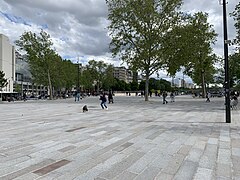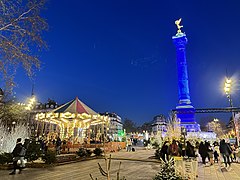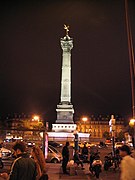Place de la Bastille
This articleneeds additional citations forverification.(November 2022) |
 The July Column, with the new pedestrian area at the south side (after the removal of the large road in 2019-2021) | |
| Length | 215 m (705 ft) |
|---|---|
| Width | 150 m (490 ft) average |
| Arrondissement | 4th,11th,12th |
| Quarter | Arsenal, Roquette, Quinze-Vingts |
| Nearest metro station | Bastille |
| Coordinates | 48°51′11″N2°22′9″E/ 48.85306°N 2.36917°E |
| Construction | |
| Completion | 27 June 1792 |
ThePlace de la Bastille(French pronunciation:[plasdəlabastij]) is a square inPariswhere theBastille prisononce stood, until thestorming of the Bastilleand its subsequent physical destruction between 14 July 1789 and 14 July 1790 during theFrench Revolution.No vestige of the prison remains.
The square straddles 3arrondissementsof Paris, namely the4th,11thand12th.The square and its surrounding areas are normally called simplyBastille.TheJuly Column(Colonne de Juillet) which commemorates the events of theJuly Revolution(1830) stands at the center of the square. Other notable features include theBastille Opera,theBastille subway stationand a section of theCanal Saint Martin.Prior to 1984, the formerBastille railway stationstood where theopera housenow stands.
The square is home to concerts and similar events. The north-eastern area of Bastille is busy atnightwith its many cafés, bars, night clubs, and concert halls. As a consequence of its historical significance, the square is often the site or point of departure of political demonstrations, including the massiveanti-CPE demonstration of 28 March 2006.
History
[edit]Early history of the Bastille
[edit]The Bastille was built between 1370 and 1383 during the reign of KingCharles Vas part of the defenses of Paris; the structure was converted into a state prison in the 17th century byRichelieu,who was kingLouis XIII's chief minister. At that time it primarily housedpolitical prisoners,but also religious prisoners, "seditious"writers, and young rakes held at the request of their families. It began to acquire a poor reputation when it became the main prison for those taken underlettres de cachetissued by the King of France.
By the late 18th century, the building was made up of eight close-packed towers, around 24 m (80 ft) high, surrounding two courtyards and the armoury. The prisoners were held within the 5-7 story towers, each having a room around 4.6 m (15 ft) across and containing various articles of furniture. The infamous cachots (dungeons), the oozing, vermin-infested subterranean cells were no longer in use, since the respective reigns ofLouis XVandLouis XVI,who both worked on reforming the penal system in France. The governor of the prison was given a daily allowance per prisoner, the amount depending on their status—from nineteenlivresper diemfor scientists and academics down to three for commoners. Although its prisoners' conditions were better than in many other prisons in France, including the dreadedBicêtrein Paris, popular literary accounts focused on the Bastille as a place of horror and oppression and a symbol of autocratic cruelty.
Storming of the Bastille
[edit]The confrontation between the commoners and theAncien Régimeultimately led to the people of Paris storming the Bastille on 14 July 1789, following several days of disturbances. At this point, the prison was nearly empty, with only seven inmates: four counterfeiters, two madmen, and a young aristocrat who had displeased his father. The regular garrison consisted of about 80 'invalides' (veteran soldiers no longer capable of service in the field) under GovernorBernard-René de Launay.They had however been reinforced by a detachment of 32grenadiersfrom one of theSwissmercenaryregiments summoned to Paris by the Monarchy shortly before 14 July.

A crowd of around 600 people gathered outside around mid-morning, calling for the surrender of the prison, the removal of the guns and the release of the arms and gunpowder. Two people chosen to represent those gathered were invited into the fortress and slow negotiations began.
In the early afternoon, the crowd broke into the undefended outer courtyard and the chains on the drawbridge to the inner courtyard were cut. A spasmodic exchange of gunfire began; in mid-afternoon the crowd was reinforced by mutinousGardes Françaisesof the Royal Army and two cannons. De Launay ordered a ceasefire; despite his surrender demands being refused, he capitulated and the victors swept in to liberate the fortress at around 5:30.
Later history
[edit]
On 16 June 1792, the area occupied by theBastillewas turned into a square celebratingliberty,and acolumnwould be erected there. The first stone was laid byPalloy;however, construction never took place, and a fountain was built instead in 1793.
In 1808, as part of several urban improvement projects for Paris,Napoléonplanned to have a monument in the shape of an elephant built here, theElephant of the Bastille.It was designed to be 24 m (78 ft) in height, and to be cast from the bronze ofcannonstaken from the Spanish. Access to the top was to be achieved by a stairway set in one of the legs. However, only a full-scale plaster model was built.Victor Hugoimmortalized the monument in the novelLes Misérableswhere it is used as a shelter byGavroche.The monument was demolished in 1846.
In 1833,Louis-Philippedecided to build theJuly Columnas originally planned in 1792. It was inaugurated in 1840.
The area today
[edit]The current Place de la Bastille is located on the former fort's site. In addition to the July Column, it is also home to theOpéra Bastille.The large ditch (fossé) behind the former fort has been transformed into amarinafor pleasure boats, theBassin de l'Arsenal,to the south, which is bordered by theBoulevard de la Bastille.To the north, a coveredcanal,theCanal Saint-Martin,extends north from the marina beneath the vehicular roundabout that borders the location of the fort, and then continues for about 4.4 kilometers to thePlace de la Bataille-de-Stalingrad.
On Thursdays and Sundays, a large, open-air market occupies part of the park to the north of the Place de la Bastille, along theBoulevard Richard-Lenoir.Consumers can find fresh fruit, fish, meat, cheese and bread along with clothing and typical flea market items.
Some undemolished remains of one tower of the fort were discovered during excavation for theMétro(rail mass-transit system) in 1899, and were moved to a park (theSquare Henri-Galli) a few hundred metres away, where they are displayed today. The original outline of the fort is also marked on the pavement of streets and pathways that pass over its former location, in the form of special paving stones. A café and some other businesses largely occupy the location of the fort, and theRue Saint-Antoinepasses directly over it as it opens onto the roundabout of the Bastille.
Gallery
[edit]- New situation after the relayout and the removal of the large road south of the monument (2021)
-
Now with a pedestrian space at the south side of the monument
-
the contours of the formerBastillefort
- Old situation with the large road south of the monument (before the relayout of 2019-2021)
See also
[edit]External links
[edit]- Satellite image from Google Maps
- Images of the July Column(Insecula)
- Gilded statue, Génie de la Liberté, at the summit of the Column(Webshotsuser photo - links to bigger version)
- L'Éléphant de la Bastille
- Place de la Bastillecurrent photographs and of the years 1900
- The 1974 Bastille day Parade onf the Place de la Bastille,full video broadcast by the FrenchNational Audiovisual Institute
- Place de la Bastille
- 1792 establishments in France
- Buildings and structures completed in 1792
- Squares in Paris
- Storming of the Bastille
- Bastille
- Buildings and structures in the 4th arrondissement of Paris
- Buildings and structures in the 11th arrondissement of Paris
- Buildings and structures in the 12th arrondissement of Paris
- Odonyms referring to a building












